Entertaining Comics, more commonly known as EC Comics, was an American comic book publisher specialized in horror fiction, crime fiction, satire, military fiction, dark fantasy, and science fiction from the 1940s through the mid-1950s, notably the Tales from the Crypt series. Initially, EC was owned by Maxwell Gaines and specialized in educational and child-oriented stories. After Max Gaines died in a boating accident in 1947, his son William Gaines took over the company. He began to print more mature stories, delving into horror, war, fantasy, science-fiction, adventure, and other genres. Noted for their high quality and shock endings, these stories were also unique in their socially conscious, progressive themes that anticipated the Civil Rights Movement and the dawn of the 1960s counterculture. In 1954–55, censorship pressures prompted it to concentrate on the humor magazine Mad, leading to the company's greatest and most enduring success. Consequently, by 1956, the company ceased publishing all its comic lines except Mad.
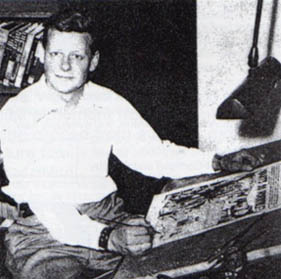
Graham J. Ingels was a comic book and magazine illustrator best known for his work in EC Comics during the 1950s, notably on The Haunt of Fear and Tales from the Crypt, horror titles written and edited by Al Feldstein, and The Vault of Horror, written and edited by Feldstein and Johnny Craig. Ingels' flair for horror led EC to promote him as Ghastly Graham Ingels, and he began signing his work "Ghastly" in 1952.

The Vault of Horror is an American bi-monthly horror comic anthology series that was published by EC Comics from 1950 to 1955 created by Bill Gaines and Al Feldstein. The magazine began in March 1948 as War Against Crime. It continued under this title for 11 issues before becoming The Vault of Horror with issue #12. The comic ran for 29 issues until being discontinued after issue #40.
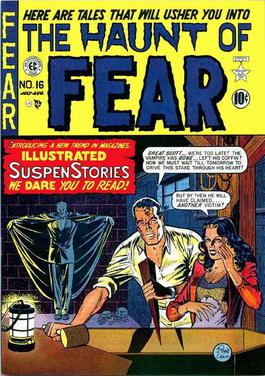
The Haunt of Fear is an American bi-monthly horror comic anthology series that was published by EC Comics from 1950 to 1954 created by Bill Gaines and Al Feldstein. The magazine began in June 1947 as Fat and Slat. It continued under this title for four issues before becoming Gunfighter (#5–14). It was retitled The Haunt of Fear with issue #15 (1). The numbering was reset after #17 (3). The comic bore this title for 28 issues until being discontinued after issue #28.

Two-Fisted Tales is an anthology war comic published bi-monthly by EC Comics in the early 1950s. The title originated in 1950 when Harvey Kurtzman suggested to William Gaines that they publish an adventure comic. Kurtzman became the editor of Two-Fisted Tales, and with the dawn of the Korean War, he soon narrowed the focus to war stories. The title was a companion comic to Frontline Combat, and stories Kurtzman wrote for both books often displayed an anti-war attitude. It returned to adventure-themed stories in issues #36 through #39, co-edited by John Severin and Colin Dawkins, with a cover-title change to The New Two-Fisted Tales.

Crime SuspenStories was a bi-monthly anthology crime comic published by EC Comics in the early 1950s. The title first arrived on newsstands with its October/November 1950 issue and ceased publication with its February/March 1955 issue, producing a total of 27 issues. Years after its demise, the title was reprinted in its entirety, and four stories were adapted for television in the HBO's Tales From The Crypt.
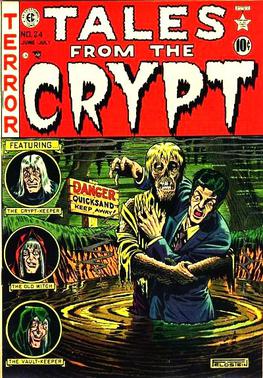
Tales from the Crypt is an American bi-monthly horror comic anthology series that was published by EC Comics from 1950 to 1955 created by Bill Gaines and Al Feldstein. The magazine began in March 1947 as International Comics. It continued under this title for five issues before becoming International Crime Patrol (#6) and Crime Patrol (#7–16). It was retitled The Crypt of Terror with issue #17. Two more issues were published under this title before it was rebranded as Tales from the Crypt for issue #20. The comic bore this title for 27 issues until being discontinued after issue #46.
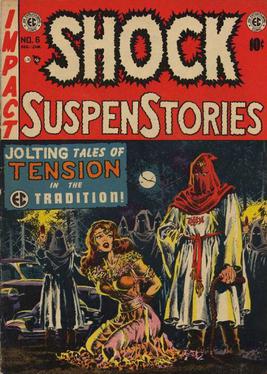
Shock SuspenStories is an American bi-monthly comic book anthology series that was published by EC Comics from 1952 to 1955 created by Bill Gaines and Al Feldstein. The magazine began in February/March 1952 and ran for 18 issues until being discontinued after the December/January 1955 issue. It covered a broad range of topics, including crime, science fiction, and horror.
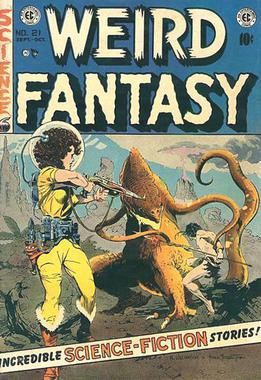
Weird Fantasy is an American dark fantasy and science fiction anthology comic that was part of the EC Comics line in the early 1950s. The companion comic for Weird Fantasy was Weird Science. Over a four-year span, Weird Fantasy ran for 22 issues, ending with the November–December 1953 issue.

Weird Science was an American science fiction comic book magazine that was part of the EC Comics line in the early 1950s. Over a four-year span, the comic ran for 22 issues, ending with the November–December, 1953 issue. Weird Fantasy was a sister title published during the same time frame.
Weird Science-Fantasy was an American science fiction-fantasy anthology comic, that was part of the EC Comics line in the early 1950s. Over a 14-month span, the comic ran for seven issues, starting in March 1954 with issue #23 and ending with issue #29 in May/June 1955.

Piracy is an EC Comics title published in the mid 1950s. The bi-monthly comic book, published by Bill Gaines and edited by Al Feldstein, began with an issue cover-dated October–November 1954. It ran for seven issues, ending with the October–November 1955 issue.
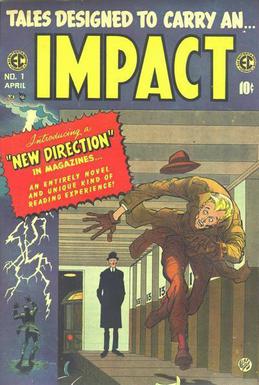
Impact was a short-lived comic book series published by EC Comics in 1955 as the first title in its New Direction line.

Incredible Science Fiction was an American science fiction anthology comic published by EC Comics in 1955 and 1956, lasting a total of four issues.

Crime Illustrated was a black-and-white magazine published by EC Comics in late 1955 and early 1956. Part of EC's Picto-Fiction line, each magazine featured three to five stories. The format alternated panels of typography with panels of illustrations. Thus, it was arranged in tiers like a comic book but eliminated hand-lettering, balloons and panel borders.

The Autumn People is a mass-market paperback collection of comic adaptations of eight short horror and crime stories by Ray Bradbury, gathered from the pages of the EC Comics comic books of the 1950s. It is one of five EC collections published by Ballantine Books between 1964 and 1966, and one of two made up of comic adaptations of Bradbury's work. The presentation of the material is problematic at best, since the color comic book pages are represented in black and white and broken into horizontal strips to fit the mass-market paperback format. Still, the collections are historically important. They were the first attempt to resurrect the EC comics, only a decade after public outcry had driven them off the racks. They were the first introduction of those comics to a generation of readers too young to remember them in their first run.

The EC Archives are an ongoing series of American hardcover collections of full-color comic book reprints of EC Comics, published by Russ Cochran and Gemstone Publishing from 2006 to 2008, and then continued by Cochran and Grant Geissman's GC imprint (2011–2012), and finally taken over by Dark Horse in 2013.
Russ Cochran was a publisher of EC Comics reprints, Disney comics, and books on Hopalong Cassidy, Chet Atkins, Les Paul, and vacuum tubes. He was a publisher for over 30 years, after quitting his job as a physics professor.

Tales from the Crypt is a mass-market paperback collection of eight horror comic stories gathered from the pages of the EC Comics comic books of the 1950s. It is one of five such collections published by Ballantine Books between 1964 and 1966. The presentation of the material is problematic at best, since the color comic book pages are represented in black and white and broken into horizontal strips to fit the mass-market paperback format. Still, the collections are historically important. They were the first attempt to resurrect the EC comics, only a decade after public outcry had driven them off the racks. They were the first introduction of those comics to a generation of readers too young to remember them in their first run.

















